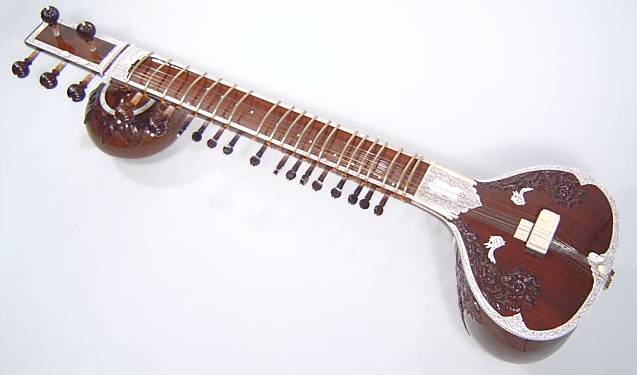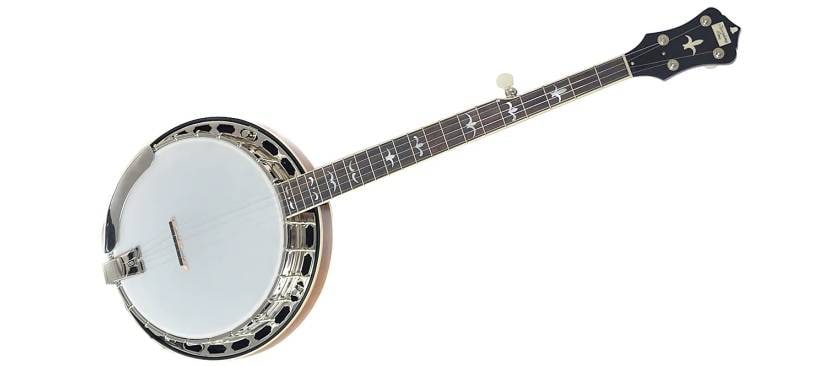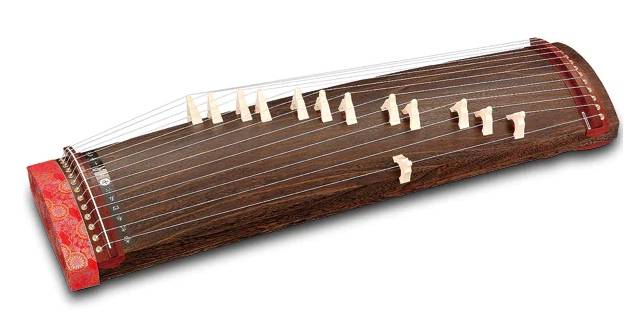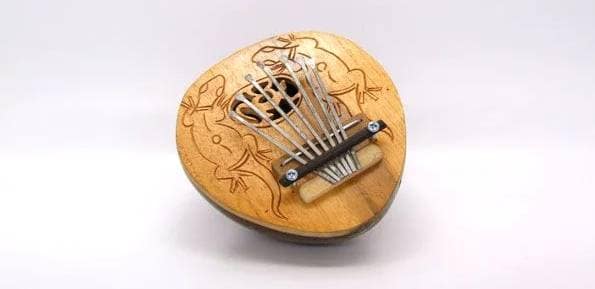■ Previous GM Sound Source Series
GM Sound Source 01: Ancient GM Sound Sources
GM Sound Source 02: Piano Category
GM Sound Source 03: Chromatic Percussion Category
GM Sound Source 04: Organ Category
GM Sound Source 05: Guitar Category
GM Sound Source 06: Bass Category
GM Sound Source 07: Orchestra Category
GM Sound Source 08: Ensemble Category
GM Sound Source 09: Brass Category
GM Sound Source 10: Reed Category
GM Sound Source 11: Pipe Category
GM Sound Source 12: Synth Lead Category
GM Sound Source 13: Synth Pad Category
GM Sound Source 14: Synth SFX Category
This category is made up of ethnic instruments with their own particular characteristics, so you need to know about them to a certain extent in order to program them. In the case of stringed instruments, the characteristics of the instrument will be revealed by the tuning and playing technique. If you are programming with MIDI, it is a good idea to watch videos of people actually playing the instrument.
105 Sitar
The sitar (from India) is a relatively well-known ethnic instrument. However, its structure is complex, with around 20 strings and various variations. In addition, the strings are divided into those used for playing and those used for resonance. There are more than 10 resonance strings alone. The arched frets are attached to the neck with strings and can also be moved. The distance between the frets is basically the same as a guitar, but there are also some places where it is a whole tone. Under the arched frets, there are also resonance strings. It is a very unique structure. The table below shows an example of the tuning of the seven melody strings. Naturally, there are many other tunings as well. The unique sound is caused by the contact between the strings and the bridge. Since the melody strings are used a lot for bending and vibrato, they are a difficult instrument to program.
| 1 | 2 | 3 | 4 | 5 | 6 | 7 |
| F3 | C3 | G2 | C2 | G3 | C4 | C5 |

Sitar, CC BY-SA 3.0 (quoted from Wikipedia)
105 000 Sitar - Range C2-F5
Standard Sitar.
105 001 Sitar 2 - Range C2-F5
This is a variation with a brighter sound.
106 000 Banjo - Range D3-C6
The banjo (from the USA) is an essential instrument in country music. It has a structure with a bridge on a drum-like skin, and is made in a modern style that makes extensive use of metal and bolts. It produces a louder sound than a guitar structurally, but because it doesn't have much sustain, it is often played with detailed phrases. It has five strings, but for some reason the fifth string is short and high-pitched, as if it were an outsider. When all the strings are played with the open strings, the GonD sound is produced. The main playing technique is finger picking, where the pick is attached to the finger, and it is played mainly with arpeggios.
| 1 | 2 | 3 | 4 | 5 |
| D4 | B3 | G3 | D3 | G4 |

107 000 Shamisen - Range C3-G5
As the name suggests, the shamisen (Japan) is a three-stringed instrument. The Chinese sanxian instrument made its way to Okinawa and became the sanshin, and from there it made its way to the mainland and became the shamisen. The body of the shamisen is covered with cat or dog skin. The standard tuning is as shown in the table below, but various tunings are used depending on the song. The open string sound is often used when playing, so if you are aware of this when playing, it will sound like a shamisen. Because there are no frets like on a guitar, smooth sliding is possible, which is a difficult thing to achieve when playing with a samisen. Unlike the sanshin, the samisen is played using a plectrum with a unique shape, which is said to have originated from the plectrum used for the biwa, and this has become established. The basic way of playing is to use the plectrum to pluck the strings and then strike the skin. For this reason, the attack sound when the skin is struck is also important.
Japanese houses are made of wood, so they don't have much acoustic resonance. The shamisen is a unique tone that has been cultivated in this environment. It has a different atmosphere to both the sangen and sanshin. Perhaps because of this, if you apply too much reverb to a shamisen, it will sound completely different to a shamisen and it will sound strange. The environment in which the instrument was born has a big influence on it. The banjo mentioned above also has a similar tendency to the shamisen, perhaps because it is mainly played outdoors where there is little echo. Strangely enough, they are also structurally similar. It may be similar to the convergent evolution of living organisms. Incidentally, when you apply reverb to typical Western instruments, they become gorgeous sounding, and it usually works out positively. Even if you apply it excessively, it doesn't sound too bad.
| 1(3rd string) | 2(2nd string) | 3(1st string) |
| C4 | G3(F3) | C3 |

108 Koto
108.000 Koto - Range G3-C6
This is a Japanese musical instrument called a koto. It is also commonly called a koto (琴), but the term koto (箏) refers to the instrument with the tuning pegs that adjust the pitch of the strings. This instrument came from China, but over the years it seems to have become a unique Japanese instrument. It has 13 strings, and in the case of the standard tuning, they are tuned as follows. It is a scale similar to the minor fourth and seventh scale. When playing, the tuning of the strings is very important. This is especially true for instruments with many strings, such as the harp, which are often played in glissandos. In the case of the koto, there are techniques where you play a chord and then bend just one string, so it can be tricky to reproduce this on a GM sound source.
| 1 | 2 | 3 | 4 | 5 | 6 | 7 | 8 | 9 | 10 | 11 | 12 | 13 |
| D4 | G3 | A3 | Bb3 | D4 | Eb4 | G4 | A4 | Bb4 | D5 | Eb5 | G5 | A5 |

108 001 Taisho Koto - Range G2-Bb5
The Taisho Koto (Japan) is a musical instrument that was developed in the first year of the Taisho era, as its name suggests. It is generally thought of as a practice instrument for beginners. It has a unique style of playing, with the pitch determined by buttons like a typewriter, and it is played with a pick. The number of strings varies depending on the model, from 5 to 6, but there is only a 4-string melody course and a single bass string. The tuning is as follows, but the tuning of the bass string changes depending on the song and style.
The instrument is played like a single-stringed instrument, with the first to fourth strings played at the same time. The fifth string is treated as a sympathetic string and is not played.
| 1 | 2 | 3 | 4 | 5 |
| G4 | G4 | G4 | G3 | G2(C3、D3) |

109 000 Kalimba
The kalimba is an African instrument that is played by plucking the strings with the thumbs of both hands. It is similar in structure to a music box, but it has a simple sound. As it is designed to be played with both hands, the range of the kalimba is very narrow, and the notes that can be used are limited to a specific major scale or pentatonic scale. In the video, I tried using it freely, moving away from the original kalimba.

110 000 Bag Pipe - Range C2-F5
The bagpipe is a special reed instrument that originated in Europe. The way that the air is stored in a bag to vibrate the reed is a structure that is not seen in other wind instruments. This structure makes it possible to continuously produce sound without cutting it off, or to play several notes simultaneously.

Bagpipe, CC-0 (quoted from Wikipedia)
111 000 Fiddle - Range G3-C7
The word 'fiddle' is used in English to refer to a bowed string instrument, but it mainly refers to the violin (in Italian). The term 'fiddle' is used in country music and other genres. It can be said that fiddle is used for more ethnic and popular performances, as opposed to classical performances. The violin in GM sound sources is designed to sound like a performance in a concert hall, but the fiddle has a more open-air feel with less reverberation.

112 000 Shanai - Range C3-C5
The spelling is slightly different, but it is thought to be the Indian Shehnai. It is a double-reed instrument similar to an oboe. The actual performance has a unique pitch fluctuation and is very expressive. It is a tone that is difficult to imitate using a GM sound source that only samples specific notes. In the video, I tried to imitate it by making the pitch unstable, but I couldn't get it right.

Shehnai, CC BY 3.0 (quoted from Wikipedia)
The “sound & person” column is made up of contributions from you.
For details about contributing, click here.













![[Building Your Equipment] Assembling DTM Gear For Under A 100,000 Yen Budget!!](/contents/uploads/thumbs/5/2021/11/20211116_5_15163_1.jpg)

![[2023] Recommended Items for Music Programming - DAW/Software Instruments/Plug-ins](/contents/uploads/thumbs/2/2020/11/20201102_2_11495_1.jpg)
 定番DAWソフトウェア CUBASE
定番DAWソフトウェア CUBASE
 DTMセール情報まとめ
DTMセール情報まとめ
 ドラム音源に最適なMIDIパッド・コントローラー
ドラム音源に最適なMIDIパッド・コントローラー
 DTMに必要な機材
DTMに必要な機材
 UR-RT4 ソフト音源やループ素材をリアンプ
UR-RT4 ソフト音源やループ素材をリアンプ
 DTM・DAW購入ガイド
DTM・DAW購入ガイド















